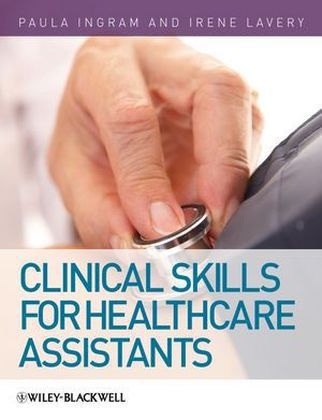
Clinical Skills for Healthcare Assistants
Wiley-Blackwell (Verlag)
978-0-470-51071-1 (ISBN)
- Titel erscheint in neuer Auflage
- Artikel merken
Clinical Skills for Healthcare Assistants is an accessible, easy to read guide, outlining the fundamental and core skills integral to clinical practice. Divided into three sections, the first looks at fundamental skills applicable to all staff, such as accountability, communication and record keeping. Section two explores core clinical skills for example respiratory care, pulse, blood glucose management, catheter care, and fluid balance. Section three outlines complex clinical skills that require more in-depth training and may be restricted to specialist areas of practice, such as medication, and intravenous cannulation. Each chapter follows the same easy to use structure, starting with the aims and objectives of the chapter, followed by the explanation of why the skill is performed, relevant anatomy and physiology, related aspects and terminology, how to perform the skill and common problems. Aimed primarily at healthcare assistants, this will also be a useful resource for newly qualified practitioners and students in health and social care.
Preface. Acknowledgements. Introduction. Section 1: Fundamental skills. 1 Accountability. Aim of this chapter. Regulatory body. What do we mean by accountability? Delegation. Related aspects and terminology. Summary. Self-assessment. Table of cases. 2 Communication in healthcare. Aim of this chapter. Why good communication is important. Communication methods. Strategies to improve communication. Related aspects and terminology. Summary of good communication. Self-assessment. Addendum. 3 Psychological care. Aim of this chapter. What is meant by psychological care? Psychological assessment in the healthcare setting. The importance of psychological care in the healthcare setting. Strategies to optimise psychological wellbeing. Pharmacological (drug-related) options. Non-pharmacological options. Therapeutic sense of self. Common problems. Summary. Self-assessment. . 4 Documentation and record keeping. Aim of this chapter. The importance and purpose of documentation in relation to clinical skills. Confidentiality in records and documentation. Types of documentation. Legal aspects relating to documentation. Strategies to improve standards of record keeping. Related aspects and terminology. Common problems. Summary. Recommendation: the review of Skills for Health (2004a-c). Self-assessment. Section 2: Core clinical skills. 5 Pulse. Aim of this chapter. What is a pulse? Relevant anatomy and physiology. Related aspects and terminology. Factors affecting the pulse rate. Terminology. Automated devices. Fetal heartbeat. Documentation. Common problems. Summary. Self-assessment. 6 Blood pressure monitoring. Aim of this chapter. What is blood pressure? Reasons for monitoring blood pressure. Who requests the test? Who can take a BP reading? What is done with the readings/information? Relevant anatomy and physiology. Related aspects and terminology. Terminology. Equipment. Sites for recording blood pressure. Taking blood pressure. Documentation. Common problems. Summary. Self-assessment. 7 Thermometry. Aim of this chapter. What is temperature? Reasons for measuring temperature. Normal limits. Relevant anatomy and physiology. Related aspects and terminology. Terminology. Taking a temperature reading. Route. Taking a temperature reading. Documentation. Common problems. Summary. Self-assessment. 8 Pulse oximetry. Aim of this chapter. What is an oxygen saturation reading? Who can perform the test? Reasons for recording an oxygen saturation level. Relevant anatomy and physiology. Related aspects and terminology. The mechanics of pulse oximetry. Equipment. Normal readings. Using a pulse oximeter. Documentation. Common problems. Summary. . 9 Respiratory care. Aim of this chapter. What do we mean by respiratory care? Relevant anatomy and physiology. Upper respiratory system. Lower respiratory system. Recording a respiratory rate. How to measure and record a respiratory rate accurately. Measuring and recording a peak expiratory flow rate. Performing suctioning. Related aspects and terminology. Common problems. Summary. Self-assessment. Addendum. 10 Urinalysis and faecal occult blood testing. Aim of this chapter. Reasons for performing urinalysis and FOB tests. Relevant anatomy and physiology. Urinalysis testing. Faecal occult blood testing. Related aspects and terminology (Tortora and Derrickson 2006). Common problems. Summary. Self-assessment. Addendum. 11 Urinary catheterisation and catheter care. Aim of this chapter. Reasons for urinary catheterisation and catheter care. Relevant anatomy and physiology. Types of catheterisation. Patient preparation for catheterisation. Insertion technique. Catheter care. Sampling. Removal of catheter. Related aspects and terminology. Terminology. Common problems. Summary. Self-assessment. 12 Venepuncture. Aim of this chapter. Reasons for performing venepuncture. Relevant anatomy and physiology. Common sites for venepuncture. Infection. Hand hygiene. Aseptic (sterile) technique. Protective clothing. Environment. Performing the skill: requirements and technique. Related aspects and terminology. Common problems. Summary. Self-assessment. 13 Blood glucose monitoring. Aim of this chapter. What causes diabetes? Reasons for performing blood glucose measurement. Relevant anatomy and physiology. Related aspects and terminology. Types of diabetes. Blood glucose levels. Hypoglycaemia. Hyperglycaemia. Common problems. Summary. Self-assessment. 14 Fluid balance and intravenous maintenance. Aim of this chapter. Reasons for monitoring fluid balance. Related anatomy and physiology. Electrolytes. Related aspects and terminology. Fluid balance charts. The intravenous route. Care of the cannula. Discontinuing an IV infusion. Common problems. Summary. Self-assessment. Section 3: Complex clinical skills. 15 Medicines. Aim of this chapter. Healthcare assistants role within medicine administration. Types of medicines. Medication prescribing and legal aspects. Related aspects and terminology. Common medications. Errors in administration and adverse reactions. Summary. 16 Peripheral intravenous cannulation. Aim of this chapter. Reasons for cannulation. Why perform peripheral IV cannulation. Relevant anatomy and physiology. How to insert and remove a peripheral IV cannula. Environment. Performing peripheral IV cannula: requirements and technique. Patient education for peripheral IV cannulation. Related aspects and terminology. Common problems/potential complications of peripheral IV cannulation. Summary. Self-assessment. 17 Recording a 12-lead ECG. Aim of this chapter. Relevant anatomy and physiology. The heart's conduction system. Electricity of the heart. Reasons for recording a 12-lead ECG. How to perform a 12-lead ECG. Related aspects and terminology. Common problems and actions. Summary. Self-assessment. Index.
| Zusatzinfo | Illustrations |
|---|---|
| Verlagsort | Hoboken |
| Sprache | englisch |
| Maße | 190 x 245 mm |
| Gewicht | 566 g |
| Einbandart | Paperback |
| Themenwelt | Medizin / Pharmazie ► Pflege |
| ISBN-10 | 0-470-51071-4 / 0470510714 |
| ISBN-13 | 978-0-470-51071-1 / 9780470510711 |
| Zustand | Neuware |
| Haben Sie eine Frage zum Produkt? |
aus dem Bereich



